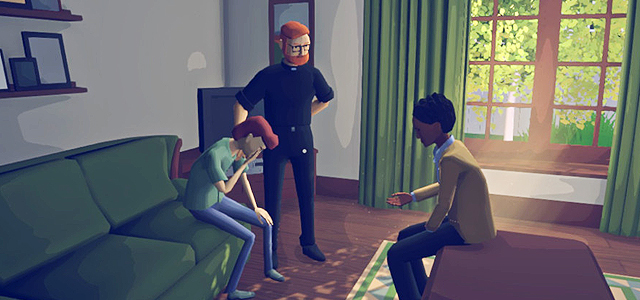Review: Virginia
Developed by Variable State
Virginia is a videogame with a story that is both genuinely surprising and told in atypical ways.
Set in the summer of 1992, Virginia takes place through the eyes of Anne Tarver, an FBI agent who newly graduated from the academy. It’s not long before Tarver is placed on two assignments. One of these is investigating the disappearance of a young boy. The other is an internal investigation into her partner for the latter case, Maria Halperin. As the story develops, this creates a dynamic of distrust and a tense atmosphere. As the story goes on, things become increasingly stranger. Backgrounds change mid-scene and motifs like buffalo, birds, and flowers constantly reappear.
Virginia is similar to other first person narrative games like Firewatch, Gone Home, and Dear Esther, short interactive journeys that take the player through a character’s experience of the story. What makes Virginia stand out is the lack of any dialogue. The story is told using visual cues and the characters’ body language. While this was a risky choice on Variable State’s part, it works surprisingly well to give the game its sense of affective impact.
Perhaps the most interesting aspect to Virginia is the way that its story makes the player repeatedly check their own moral compass. Tarver is investigating her own partner, someone she is becoming closer to as a colleague and a friend, with a view to expose her potential ethical breaches. This brings up questions about being loyal versus being complicit.
Virginia also forces the player to re-evaluate their own biases via a subplot involving the kidnapped boy’s father, who also happens to be a minister. How the player views this character, and whether they think he has anything to do with the boy’s disappearance, will no doubt be determined by how they decode the image of the man in the clerical collar.
An Artful Investigation
Built using the Unity engine, Virginia’s graphics are basic but have a beautiful artistic style. Given how much the title relies on the players’ ability to perceive what is going on without text, the in-game animation is very important and thankfully, it works well.
Games like Virginia are often derisively termed ‘walking simulators’ as they involve pacing from plot point to plot point, in the order that the player is meant to proceed. This kind of criticism could be applied to the title, as the player performs a series of actions that are tightly limited: aim the recticle at an object or a door, move the character over to it. At some points, working out what the game intends for you to aim at can prove confusing.
This leads to Virginia’s main ‘problem.’ If you do not enjoy ‘walking simulators’, Virginia probably won’t be the game that convinces you to give them a chance. Clocking at just over two hours on a leisurely play through, it’s also short game, the latest in a number of titles designed for short-burst play. While this will please time poor people such as new parents, those looking for a longer experience are bound to be disappointed.
These ‘problems’ however, are really more points of preference and when judged on its own merits, Virginia more than delivers what it sets out to accomplish.
At the time of writing, the game’s special edition can be bought for a few extra dollars at $16.95. This includes the game’s soundtrack performed by the Prague Philharmonic Orchestra.
Virginia is rated M and available on the PS4, Xbox One, and Steam.
Jonathan Foye is Insights’ Editor












